Presenting the Past: How Men and Women Talk About their Lives on the Campaign Trail
Peter Carroll
This project asks: Do men and women candidates reference their previous occupations, accomplishments, and lifestyles differently while running for office, and if so, how?
The extent to which candidates’ campaigns include messaging personal background is at the same time a unifier between groups as well as a way candidates attempt to set themselves apart from challengers. Every candidate has both a personal life and an occupation before a campaign, and while candidates may represent a vast variety of backgrounds, they all will choose to talk about them differently. This choice stems from evidence that voters use facts about a candidates history as a form of shorthand to understand to make decisions on voting (McDermott 2005). Some candidates may want to avoid discussions of their background based if there is something that may affect voters’ perceptions. Other candidates may want to highlight previous achievements in their fields that would help give support to their political stances. The question remains as to whether or not men and women behave differently in regard to these decisions. Are women more likely to message on traits about family and motherhood, or do they attempt to push back against stereotypes? Are women more likely to highlight career success in their field as an attempt to appear on par with their male counterparts? There are multiple reasons why a candidate might want to draw attention to (or conversely, avoid drawing attention to) life before the campaign.
Talking About the Past, In the Past
Before delving into the question of gendered messaging on background, we need to back up and establish context. Essentially what are the assumptions our question is based on, what makes us think there may be a difference in how men and women discuss background or personal history? The starting point of this is perception of voters. After all, the point of campaign messaging is to get voters’ attention and influence their decision making, or as John Sides (2006) puts it “one chief function of electoral campaigns is to place issues before voters” (Sides 2006, 407). It makes logical sense then that campaign messaging would be influenced by studies on the perceptions of voters. If voter perceptions of women candidates are different than they are of male candidates, then the strategies used to appeal to voters would also differ.
To begin, Wolak (2015) asks if voter participation and candidate gender are related. The study suggests that there is little to no influence of candidate gender on women’s engagement in politics. However, while the mere presence of women in a political race may not shift participation in an election, it does not mean it will not influence voters. Two studies investigate how competency and gender coding effect each other in political perception. First, Rossenwasser (1989) investigates how voters perceive the gender coding of political office and candidate and finds that at all levels of political office masculine descriptors of topics and candidates were considered more important than their feminine counterparts. Second and more recently, Branton (2018) investigates the perception of men being more competent leaders than women. Branton’s data confirm the assumption that voters perceive men as more competent leaders (importantly, when political party is held constant). These two studies both suggest that women who choose to run face an uphill battle.
Following the logic that campaign messaging would respond to and influence voter perceptions, it would make sense that candidates who are women would message differently in response. And this belief is supported by Bauer’s (2017) study about gender stereotyping of candidates; Bauer finds that candidates who are women benefit from emphasizing traits that are traditionally considered masculine. However, this approach to candidates messaging is not universal, and could also create problems of its own. Since the question at hand is about messaging on candidate past, including previous successes, it is important to look at gender and success. Heilman and Wallen (2014) do just that, looking into a study on how women who succeed at masculine coded tasks are perceived. While this study does not look specifically into politics, the authors find that “success in traditionally male domains can have deleterious consequences for women,” continuing to state it can cause women to be treated worse than equally competent men (426). In an instance like political campaigning, where likability can be a major part of success, women who run may have to walk a tightrope regarding how they message. The literature suggests that in some aspects of politics men and women are perceived the same, while in others they are perceived differently. Some studies suggest women leaning on more masculine attributes may be successful, while other studies find this approach can backfire for women candidates.
According to a study by Granato and Wong (2004), campaigns must respond to and shift voter perceptions quickly, as voters’ perception will solidify very quickly. This suggests that a successful campaign would have focused theme and tone in order to message as clearly as possible. Sides (2006) suggests the only reason for campaigning is to shape voter perception of a candidate. Sides finds that candidates focus on topics they know will be their strengths, based on past records. This helps reinforce the idea that focused campaigns will be met with success. This is reflected Meirick’s (2018) study which compared the accuracy of ads to how much attention they were given by voters. Meirick found that the more accurate an ad is the more likely it is to be viewed. If accurate information is more successful with potential voters, then it would only make sense for a candidate to lean on their strengths and successes to ensure the accuracy of their stances and messaging. Finally, another recent study on political advertising suggests that campaign ads which are focused on narratives and biographies of candidates are on the rise. All these seemingly disparate studies on ads lead me to suggest that a study on how backgrounds are used in ads is important. Background of a candidate can help focus a campaign, illustrate strengths and legitimacy on issues, and fit the biographical framework of modern ads.
Having established a few important aspects of political advertising, and how women in politics may, or may not, be perceived differently, it is time to begin a more synthesized approach. Pulling away from studies of background for a moment, the question must be asked: are women and men messaging differently? Having established the reasoning for looking into political gender differences and campaign background, a closer look at studies surrounding the campaign messaging of female candidates is the logical next step. We begin with a study by Hayes and Lawless (2016) into how male and female candidates’ message on issues. This study is important in that its design has greatly influenced the my approach. In Women on the Run, Hayes and Lawless find that candidate gender has little to no effect on the topics being discussed in campaigns. This may suggest that women candidates are not responding to voters’ perceptions, but instead are choosing to normalize their campaigns in comparison to men. However, this can be a problem as they may fall victim to the previously established stereotypes surrounding women. As earlier established by the studies on perceived competency, women are often perceived as less competent than men. A study by Ditonto (2017) supports this, finding that when a female candidates competency gets called into question in a campaign setting, it harms the candidate much more than a male candidate experiencing the same criticism. This is corroborated by study surrounding the gendering of attack ads. Cassese and Holman (2017) find that female candidates are particularly vulnerable to attacks on their traits, regardless of whether the trait is traditionally masculine or feminine.
Previous studies all seem to suggest that while women may not be messaging any differently, they are facing problems along the lines of gender anyway. So, what about women who do try to play into gender stereotypes? A study into women who choose to lean into feminine stereotypes and issues finds that women who focus their campaign on more feminine issues and traits improve their chances of success (Hernson 2003). Taking this to the extreme are women who not only break from stereotypes, but women who also break ranks with a party and play the role of a maverick. A study finds that, similarly to attacks and competency questions, this type of campaigning can damage female candidates’ chances disproportionately (Vraga 2017).
These studies create a rather blurry picture of gender and campaigning. It looks as if candidates are not explicitly playing off gender, but it is still impacting candidates’ campaigns. Furthermore, past research suggests that pieces of messaging that can be altered, but that candidates tend to “play it safe” when it comes to emphasizing specific traits and issues. A candidate’s personal background does help shape perceptions of a candidate, but it is not something a candidate can change like a stance on an issue. Because of this the only option is to emphasize or de-emphasize different parts of candidate background, which once again puts our original question in the spotlight; Do men and women reference their previous occupations, accomplishments, and lifestyles differently while running for office, and if so, how do they differ?
There remains only one aspect of the question at hand to investigate: Background of candidates. The reasoning for looking into background as an important part of campaigning is that background in a certain field or with certain levels of success serves as a cue, or connection point, that helps voters identify with and understand a candidate. McDermott (2005) studied the way voters use background as a shortcut and finds that voters often used candidate occupation as a shortcut to understanding competence and qualifications. Reflecting the logic applied to gender in politics, if it something voters are paying attention to, then it only stands to reason that campaigning will attempt to respond to this interest. Sellers (1998) finds, for example, that “candidates often campaign on issues for which they have built favorable records. Background-supported messages appear to influence individual voters. Candidates win more favorable evaluations if they focus on their records and avoid making unsubstantiated claims”. A more focused campaign, built around fields and issues a candidate has a background in, will have high chances of success. This solidifies the justifications for looking not merely into gendered campaign messaging, but gendered messaging pertaining to background.
Research Design
In order to address the complicated relationships between candidate gender (sex) and campaign strategies with respect to personal background, I carrying out a content analysis of campaign ads. I borrow heavily from Hayes and Lawless’s (2016) examination of campaign ads, tracking and counting the mention of certain types of issues, and categorizing issues based on gender. Rather than focus on campaign issues, however, I focus on candidate background.
The primary subject of the analysis are campaign ads of House candidates in the 2018 election. Specifically, races with no incumbent are selected. This will allow the study to maintain its focus on gender differences in messaging, as well as avoiding the issue of how new candidates may discuss their past differently than established candidates. The one issue that will arise from this is that by those criteria, there are very few Republican women in my sample (therefore, it may be difficult to separate out the effects of candidate party, from candidate sex).
Access to campaign ad is an additional concern. I define target ads as ads featured most prominently on the candidate’s website in the month before the election–these are generally accessible via online archiving tools. These ads were chosen based on the previously discussed point that voters make their choices quickly and campaigns attempt to convince voters as quickly as possible. With this mindset, whatever ad the campaign puts forward first is the focal point of what they want voters to hear the most clearly. It is true that some ads are not accessible even with the use of internet archiving sites, which will influence the study in some ways. On top of this, some ads may simply do not contain information on candidate background. These ads will still be collected as a part of the study, as candidates not mentioning background holds its own form of significance. A candidate may choose to ignore their past as a way of turning focus to issues, rather than personal traits.
My primary interest is in whether men and women campaign differently. Party is a main control variable. I analyze each ad and record mentions of background, previous work, and other personal history mentions. For “background” I include narrative areas like personal life and family; “previous work” includes jobs and professional achievements; “other personal history mentions” includes any other mention of background that may exist, such as educational attainment.
I also recorded candidates’ previous occupations independent of the content analysis of target ads. This information was pulled from Ballotpedia.org and Votersmart.org. This information was included in order to make sure all comparisons between groups would be fair, ensuring that percentages of candidates who discussed a particular job is only taken from the candidates in the sample who did work in that field. This helps the comparisons on messaging mean more than simply demographic breakdowns of who worked in which field.
Essentially, the main thing that will answer our question is to notice any repeating topics, trends, or themes that appear differently between women candidates and men candidates. Do women candidates more frequently mention family? Do women emphasize past professional accomplishment more than men? Or are there few sex differences when it comes to the ways that candidates campaign round personal history and previous occupation?
Before delving into an analysis of the data, a few disclaimers need to be addressed. The first is of course the problem of sample size. In an attempt to keep the conflicting variable of incumbency out of the comparisons of background, the pool of candidates available became unfortunately small. This restriction, along with the already small number of women running for office, especially in the Republican party, means that the sample collected was small. Only 6 Republican women were originally included in the selection of races with both men and women for open seats. This sample size was so low that I was forced to increase the number of Republican women and Democratic men by selecting from races in which candidates were campaigning against a similar-sex candidate. This meant random selection of Democratic men, and the selection of the rest of the Republican women, bringing the total up to 12.
There is also a minor problem with data collection in that over 5 months have passed between the election and the time of data collection. Candidates may have taken down website ads and removed videos on messaging from the internet. While archiving software did help get past this in many cases, there were still nine candidates whose messaging was relatively inaccessible, or incomplete for the purposes of this study.
How Candidates Talk About the Past, In the Present
With the previously mentioned caveats in mind, there are still a few interesting trends within the data. The first important type of messaging to address, is the total lack thereof. Figure 1 displays the rates at which candidates put forth messaging that contained no information on their personal history or personal background. The reasons for why campaign ads might not want to mention background could be varied anywhere from an attempt to focus the campaign on issues rather than character, to something more complex, like candidates wanting to keep parts of their lives more private. The data suggest there may be some difference in messaging on background in general, based on differences in lack of messaging. Based on the data, women across both parties had higher likelihoods of not mentioning their backgrounds altogether. Figure 1 shows that 13.64% of women Democratic candidates did not mention background, compared to only 7.69% of men Democratic candidates. The data on the Republican candidates shows an even bigger disparity, with every male Republican included in the study messaging on background in some way and 25% of Republican women choosing not to. There are several possible explanations for these differences, including Cassese’s suggestion that women candidates were more vulnerable to attacks on traits, leading women candidates to simply avoid talking about character, and instead focus messaging on political issues.
Figure 1. Percentage of Candidates with Target Ads that Do Not Mention Background
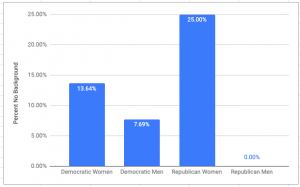
The aspect of background and personal history discussed most frequently by 2018 candidates was family. For the sake of this study, mentions of family in messaging could be one, or multiple mentions of grandparents, parents, spouses, children, and even in some cases grandchildren. The prevalence of the discussion of family among all candidates, men and women from both parties, suggests that messaging about family is a shorthand for candidates to connect with voters from all groups. Men were slightly more likely than women to mention family. As seen in Figure 2, 52.38% of Republican men mentioned family in their messaging, while only 33.33% of Republican women did the same. The story is largely the same for the Democrats, where 61.54% of men candidates mention family while only 50% of women candidates similarly mentioned family. There are many reasons that candidates could be choosing to message this way. One such reason was previously mentioned in the study by Bauer which suggested that playing into feminine traits can hurt women candidates’ chances at success.
Figure 2. Percentage of Candidates with Ads that Mention Candidate Family
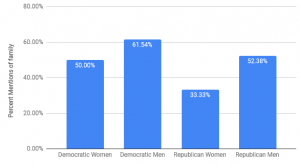
Another type of personal messaging that needs to be addressed is mentions of immigration in the family. Immigration is currently one of the most contentious issues in politics, and a candidate’s choice to not only take a stance on it, but to also connect it to their background is certainly not a decision made on a whim. And this is reflected in the data as shown in Figure 3, with only 9.52% of Republican men, 7.69% of Democratic men, and 4.55% of Democratic women mentioned immigration history in their family. Republican women on the other hand had a surprisingly large proportion of candidates that referred to immigration in their family, at 25%. There could be many reasons for this, such as appealing to different areas of the country or different groups of voters. However, I would guess that this is a symptom of the small sample size of Republican women compared to the other groups. A repeat of the study with a larger sample would have to be done before any conclusions could be drawn.
Figure 3. Percentage of Candidates with Ads Mentioning Family Immigration
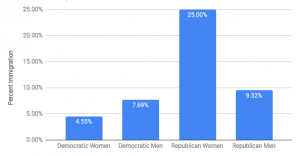
Moving away from the more personal messaging into more professional background information comes candidate messaging on previous military service. The percentages here, and in the following analysis of profession are not percentages of the whole group, but rather compared to the candidates who had had backgrounds in that field, as explained in the research design. For example, Figure 4 shows that 100% of the Democrats who served in the military referred to it in their messaging, regardless of gender. Republicans in the meantime offer a slightly more complicated story. None of the women who ran as Republicans had any military experience and therefore, they were omitted from the graph. Of the Republican men who were in the military, 83% of them referred to it. There does not appear to be much to take away from this data. It looks as if the main difference in messaging happens across party lines rather than gender lines. The Democrats show absolutely no difference in their messaging, with both always mentioning military service. Meanwhile the lack of any Republican women who served in the military makes comparison within the Republican party impossible.
Figure 4. Percentage of Target Ads Mentioning Candidates’ Military Background
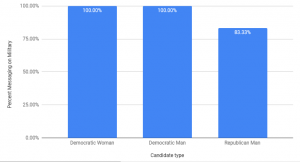
Along with the gender breakdowns comes the important previous professions candidates are interested in letting voters know about. For example, mentions of previous work in business, whether it be small or large, was a common trend through ought the messaging. This makes sense, as according the to the Brookings Institute, in 2015 over half of the House of Representatives was from a business or banking background (Kramer 2017). While many politicians are more likely to come from background in business, Figure 5 suggests that across the board they are less likely to message on it when compared to messaging on, for example, military service, Republican men, Republican women, and Democratic men with backgrounds in business only referred to it 50% of the time, with Democratic women of the same profession being slightly lower at 37.5%. Once again there is not a strong trend here, as many of the groups have identical proportions, and the difference in Democratic women is not that large.
Figure 5. Percentage of Candidates with Target Ads Mentioning Business Background
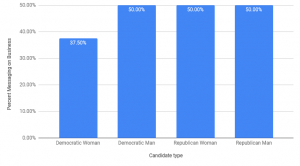
Alongside business being one of the largest backgrounds of politicians, many also come from backgrounds in law. For the sake of the study, any candidate who discussed having history as a prosecutor, an attorney, or simply having attended law school was categorized as having a background in law. Interestingly, in the data collected for this study no Republican candidates discussed history in law, as seen in Figure 6, even though a few did in fact have a history in law. Among the Democrats however, 57.14% of women mentioned law backgrounds, while only 25% of men did.
Figure 6. Percentage of Candidates Ads Mentioning Background in Law
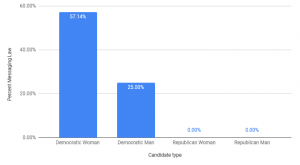
The third large profession in politics is previous government work, consisting of lower level elected office, appointed positions, as well as other miscellaneous government jobs–for example, two candidates mentioned working at the Pentagon before running for office. Overall, the first thing to come from the data was that the Democrats discussed previous work more than the Republicans, regardless of gender, according to Figure 7. Within the Democratic party, men running for office in 2018 messaged about previous government work more than women, with men at 42.86% compared to women at 37.5%. In the Republican party, men and women messaged about political work equally, at 33.33%. These statistics reflect the previous findings in other sections in two ways. The Democratic party seems to have a larger difference between how men and women message, while the Republican party appears to be similar across men and women campaigning for office. This once again cannot serve as a conclusion, but rather as a point to begin future research by comparing the gender breakdown of certain fields to the proportion of which political candidates talk about their history within those fields.
Figure 7. Percentage of Candidates with Ads that Mention Background in Government
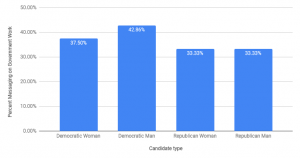
Having discussed the three primary professions that politicians hold before running for office it only makes sense to pause here and look at occupation as a whole. In the research design I explained how candidates messaging would be coded as typical, specifically with regard to previous occupations. What this amounted to in practice was if the candidates mentioned a background in law, government, or business, they were considered messaging about their professional background in a manner typical for a political candidate. Overall, this measure of messaging suggests that candidates do not message very differently on their background professions, regardless of party or gender. Figure 8 shows that Democratic women mentioned political backgrounds typical of politicians 47.06% of the time, with Democratic men at 45.45%, Republican women at 50% and Republican men at 47.06%. While women did have a higher rate across both parties, it is not higher by very much, and whether or not the difference is significant is outside of the scope of this study, as the issues with sample size restrict explanatory power. It could suggest that maybe women are playing into traditional stereotypes of politicians in an attempt to normalize their position in politics, but that speculation cannot be confirmed without further study.
Figure 8. Percentage of Candidates with Ads mentioning Background in Fields Typical of Politicians
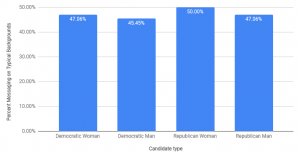
Finally, on the opposite side of leaning into stereotypes regarding political figures, there are candidates who chose to explicitly state they are not politicians. At first, I did not think this would be important to discuss, but as rhetoric around being an outsider had such a strong place in the 2016 election, I figured it would be interesting to see if candidates would embrace or reject that sort of messaging in 2018. As the data on professions was compared to their respective professions, the percent here are created from the candidates who have no background in politics. Figure 9 shows the very strange outcome of the data, showing that 13.33% of female Democratic candidates mentioned being an outsider, while 16.67% of Republican men did. The other two groups did not have a single mention of this. Instead of attempting to draw any type of conclusion from this, I will merely once again reiterate that this study was limited by its data and should re-performed under different circumstances. There does not appear to be any trend whatsoever in this data, whether across party or gender, and in order to either confirm that conclusion or find a trend, a larger sample would be needed.
Figure 9. Percentage of Candidates with Ads Mentioning Background in Politics
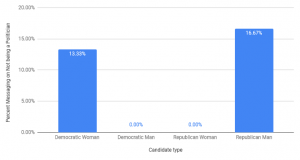
Conclusion
Despite the limitations of the research design used in this project, the findings above suggests that there could be differences in how men and women message about, or refer to, their personal family and career backgrounds. In the brief discussion that follows, I suggest possible ways to improve on this analysis.
The first problem to handle would be the sample size issue. Unfortunately, when studying women in politics there is an inherently smaller population than men. If this was not the case, studies of this type would not be important. One way to deal with this issue would be to of course expand the sample size, but every way to expand has its issues. By looking at campaign messaging throughout history you could find more female candidates, but never more than there were in 2018, as it was a record breaking year. The restriction on only studying races without incumbents could be removed, but there would have to be some way to control for how incumbents’ message about previous work in office, that newcomers simply could not discuss. And of course, a race with more participants than the races for house of representatives could be studied, such as local or state positions throughout the nation. That being said, these races could prove to be difficult to find messaging for, and some very small races may have almost no messaging on background even if it is accessible.Another way to improve this study in the future would be to focus much more closely on professional backgrounds instead of background messaging in general. Specifically, a comparison of the demographic breakdown of fields could be compared with how candidates messaging reflects their previous field. For example, are women candidates reflecting the expected proportion of women in the fields they are from, or are they emphasizing their work in certain fields more than their male counterparts? Or are women coming from field less typical of average politicians? Further study could reveal a lot more about how men and women discuss their professions differently, as this study shows there may be differences in some areas.
This study serves as an imperfect but important first look into how the gender of candidates plays into their messaging on background. Much like the literature referenced earlier, this study suggests that perhaps some differences in messaging exist, but not in all areas. The lower rates of female candidates messaging on topics like family, and certain professions suggest that there may be differences in how candidates message, but the conflicting variable of occupational demographics in the latter makes conclusions difficult. Other variables like background in law, business, or not previously being involved in politics showed no trend, reflecting the suggestion by Hayes and Lawless (2016) that male and female candidates do not message differently. The most interesting finding remains Figure 1, which suggests that overall, women running for office are talking about all aspects of their background less often when compared to men running for office. Future research would be well served examining whether this is a consequence of gender stereotypes–in the minds of candidates and voters–and whether these differences in messaging are related to electoral outcomes.
Appendix
Coding Instrument
| Personal Background | Professional Background |
| Family, Parents, Children, Spouse, Grandchildren, Immigration, Education, Community, Religion | Law School, Law, Journalism, Teacher, Politician, Government Work, Business, Small Business, Doctor, Healthcare, Social Work, Agriculture, Engineering, Non Profit, Not a Politician. |
References
“Ballotpedia.” Ballotpedia. Accessed April 22, 2019. https://ballotpedia.org/Main_Page.Bauer, Nichole M. 2017. “The Effects of Counterstereotypic Gender Strategies on Candidate Evaluations.” Political Psychology 38, no. 2: 279-295.
Branton, Regina, Ashley English, Samantha Pettey, and Tiffany D. Barnes. 2018. “The Impact of Gender and Quality OpPosition on the Relative Assessment of Candidate Competency.” Electoral Studies 54: 35-43.
Cassese, Erin C., and Mirya R. Holman. 2017. “Party and Gender Stereotypes in Campaign Attacks.” Political Behavior: 1-23.
Coffé, Hilde, and Elizabeth Theiss-Morse. 2016. “The Effect of Political Candidates’ Occupational Background on Voters’ Perceptions of and Support for Candidates.” Political Science 68 (1): 55–77.
Ditonto, Tessa. 2017. “A High Bar or a Double Standard? Gender, Competence, and Information in Political Campaigns.” Political Behavior 39 (2): 301-325.
Granato, Jim, and MC Sunny Wong. 2004. “Political Campaign Advertising Dynamics.” Political Research Quarterly 57(3): 349-361.
Hayes, Danny, and Jennifer L. Lawless. 2016. Women on the Run: Gender, Media, and Political Campaigns in a Polarized Era. Cambridge University Press.
Heilman, Madeline E., Aaron S. Wallen, Daniella Fuchs, and Melinda M. Tamkins. 2004. “Penalties for Success: Reactions to Women Who Succeed at Male Gender-Typed Tasks.” Journal of Applied Psychology 89 (3): 416.
Herrnson, Paul S., J. Celeste Lay, and Atiya Kai Stokes. “Women running “as women”: Candidate gender, campaign issues, and voter-targeting strategies.” The Journal of Politics 65, no. 1 (2003): 244-255.
Kramer, Curtlyn, and Curtlyn Kramer. 2017. “Vital Stats: The Growing Influence of Businesspeople in Congress.” Brookings. Accessed April 10, 2019. https://www.brookings.edu/blog/fixgov/2017/02/17/vital-stats-businesspeople-in-congress/.
McDermott, Monika L. 2005. “Candidate Occupations and Voter Information Shortcuts.” The Journal of Politics 67 (1): 201-219.
Meirick, Patrick C., Gwendelyn S. Nisbett, Lindsey A. Harvell-Bowman, Kylie J. Harrison, Matthew D. Jefferson, Tae-Sik Kim, and Michael W. Pfau. 2018. “To Tell the Truth: Ad Watch Coverage, Ad Tone, and the Accuracy of Political Advertising.” Political Communication 35 (3): 450-469.
Rosenwasser, Shirley Miller, and Norma G. Dean. 1989.”Gender role and political office: Effects of Perceived Masculinity/Femininity of Candidate and Political Office.” Psychology of Women Quarterly 13 (1): 77-85.
Sellers, Patrick J. 1988. “Strategy and Background in Congressional Campaigns.” American Political Science Review 92 (1): 159-171.
Sides, John. 2006. “The Origins of Campaign Agendas.” British Journal of Political Science 36 (3): 407-436.
U.S. Census Bureau; American Community Survey, 2017 American Community Survey 5-Year Estimates, Table S2401; generated by Peter Carroll; using American FactFinder; <http://factfinder.census.gov>; (10 April, 2019).
Vafeiadis, Michail, Ruobing Li, and Fuyuan Shen. 2018. “Narratives in Political Advertising: An Analysis of the Political Advertisements in the 2014 Midterm Elections.” Journal of Broadcasting & Electronic Media 62, (2): 354-370.
Vraga, Emily K. 2017. “Which Candidates can be Mavericks? The Effects of Issue Disagreement and Gender on Candidate evaluations.” Politics & Policy 45 (1): 4-30.
Wolak, Jennifer. 2015.”Candidate Gender and the Political Engagement of Women and Men.” American Politics Research 43 (5): 872-896.
